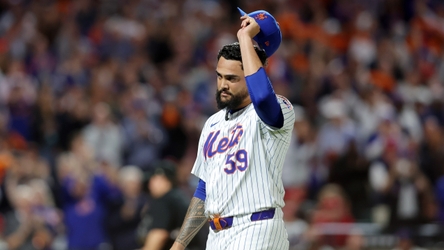On the night of what was surely his biggest personal triumph in the big leagues, slamming the door on the Philadelphia Phillies as he pitched the Mets to within one win of capturing the NLDS, Sean Manaea reflected on his unlikely rise from what he called “rock bottom” two years ago.
It was October of 2022 and, at age 30 he was considered an underachiever, a first-round draft pick who had never lived up to the potential others saw in him.
Or as he put it Tuesday night, even after throwing a seven-inning gem in the Mets’ 7-2 win at a raucous Citi Field: “I’ve had a lot of ups in my career, but way more downs.”
A disappointing season as a starter with the San Diego Padres that year pushed him into the bullpen for the postseason, and in Game 4 of the NLCS against this same Philadelphia outfit, he was given a chance for redemption of sorts, entering the game with a 4-3 lead in the fourth inning.
Only he immediately had a blow-up inning, allowing five runs that pretty much cost the Padres the game, and with one more loss the NLCS as well.
Manaea was distraught.
“That night I emailed Driveline,” the left-hander recalled. “I said, ‘something’s gotta change. I’ve gotta fix this.'”
So he went to the data-driven performance training center in the Seattle area to remake himself, working with weighted balls to increase his velocity while also learning to throw a sweeper. Some of the work paid off in 2023 with the San Francisco Giants, especially late in the season when he came out of the bullpen and made quality starts in September.
The Mets thought he was turning a corner, signing him to a short-term deal, and, of course, they couldn’t have been more right, especially after Manaea decided to lower his arm angle about halfway through the season to try and simulate Chris Sale’s delivery. The move turned him into a monster in the second half of this season.
Yet he had shrunk from the moment in Milwaukee in a crucial late-season game two weeks ago, and then pitched well in the Wild Card Series there but nothing like the dominance the Mets had come to expect.
And so there were whispers among baseball people that perhaps he just wasn’t built for handling pressure. He’d had other poor outings in the postseason besides the one in the NLCS two years ago when he was a young pitcher for the Oakland A’s.
All of which added up to a 10.66 post-season ERA going into Tuesday.
“He’s always been up and down,” one major-league scout told me Tuesday night, “but he had some of his worst outings of his career in the postseason. The book on him was that he got too amped up, that he had a hard time controlling his emotions, and because of that he had a hard time executing pitches.
“But he looks like a different guy now. He pitched today like the guy a lot of us always thought he could be. In a huge game. That says a lot.”
Yes, Manaea met the moment, pitching seven shutout innings while the Mets built a 6-0 lead, before an infield hit in the eighth wound up going on his record, with reliever Phil Maton in the game. And more than his six strikeouts, the 19 swings-and-misses he got were an indication of how much he dominated the Phillies.
That is, after the first inning, when the first three Phillies he faced hit rockets at 106 mph or higher off the bat, but all right at fielders.
Again it looked like Manaea was getting in his own way, not executing pitches in the post-season, but this time he gathered himself after that first inning and started making pitches.
Mendoza said he sensed something different about Manaea.
“He’s had poise before but his demeanor was different today,” Mendoza said. “There was something special about it.”
It translated most notably in the sixth inning. After he walked Kyle Schwarber and Trea Turner to start the frame, here came Bryce Harper to the plate with what proved to be the turning point of the game.
Mendoza said afterward he was close to going to the bullpen at that point.
Manaea struck out Harper on three pitches, getting swings-and-misses against a sequence of perfectly executed pitches: an 85 mph changeup that moved down and in, a 79-mph sweeper toward the outside corner, and finally, a 77-mph sweeper off the outside corner that Harper couldn’t have reached with a paddle.
Slow, slower, and slowest.
“To me, that was the moment that you could really see his poise,” the scout said. “That’s a moment where a pitcher in trouble with a good fastball like he wants to throw harder. Instead, he went softer and executed pitches. Just a great piece of pitching.”
Mendoza said he thought it gave Manaea his momentum back, and he went on to fool Nick Castellanos a bit as well, getting him to hit an off-balance liner that turned into an inning-ending double play when Schwarber was doubled off second.
And from there Manaea pitched one more scoreless seventh to get the Mets deep into the game, something that was crucial with their bullpen shaky lately.
Soon enough it was over, complete with a standing ovation coming out of the game in the eighth that made Manaea emotional, partly because, he said, he had found out earlier in the day that his Aunt Mabel had died.
And partly because it was a culmination of all the work Manaea had put in to reinvent himself as a pitcher after that haunting night in October of 2022 and overcome his label as an underachiever.
“It’s such an incredible feeling to persevere through all of that,” Manaea said. “I’m super proud of myself.”
He is not the only reason the Mets continue on this magic carpet ride, of course. Pete Alonso has re-discovered his power stroke, Jesse Winker continues to be an invaluable piece of the puzzle, and Jose Iglesias continues to lead the world in two-out clutch hits.
It all made for a Citi Field party of sorts on Tuesday night. The fans reveled in it. But perhaps no one appreciated it more than one Sean Manaea.
Read the full article here


























